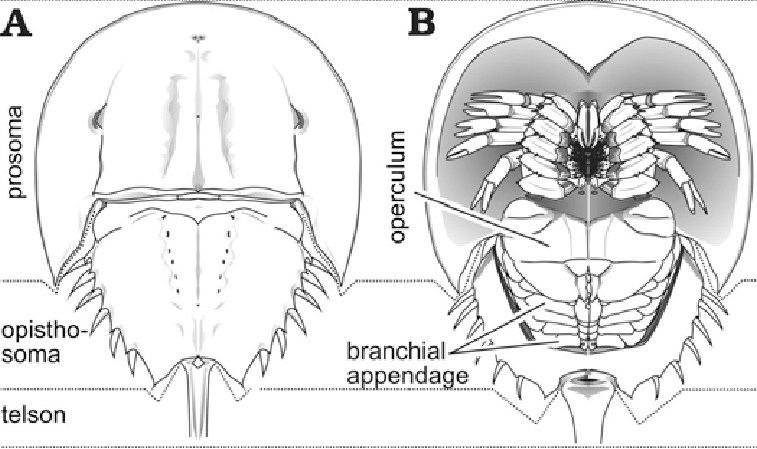Limulus – Zoology Notes – For W.B.C.S. Examination.
লিমুলাস – প্রাণীবিদ্যা নোটস – WBCS পরীক্ষা।
Horseshoe crabs are fascinating creatures. They are one of the few animals that has no predators, other than humans who capture horseshoe crabs primarily for bait. A protein found in the blood of horseshoe crabs is used to detect impurities in intravenous medications; the animals are apparently not harmed during blood extraction. Horseshoe crab blood has also been used in cancer therapy research, leukemia diagnosis and to detect vitamin B12 deficiency.Continue Reading Limulus – Zoology Notes – For W.B.C.S. Examination.
Another interesting fact is that horseshoe crabs are quite literally “blue blood.” Oxygen is carried in the blood of the horseshoe crab by a molecule that contains hemocyanin, which contains copper causing the blood to turn blue when exposed to air. Most red-blooded animals carry oxygen in iron-rich hemoglobin causing their blood to turn red when exposed to air.
The larger female horseshoe crab can reach up to 60 cm in length and can weigh up to 5 kg. The U- or horseshoe-shaped carapace(shell) is smooth and brown, although in some environments the carapace is covered with epiphytic plants and epizooic animals(organisms which live on the outer surface of other organisms and can grow so much that the carapace is no longer visible). This is usually observed toward the end of the horseshoe crab’s lifespan of approximately 19 years. During its formative years, the horseshoe crab sheds its carapace periodically, or molts, to accommodate its growing body. The new skeleton is flexible so that it can accommodate the increased body size. The new carapace then hardens and its color forms during tanning of its protein component.
The body is divided into an anterior cephalothorax and a posterior abdomen. The spike-shaped tail, or telson, functions as a tool for digging in sand and a lever if the animal finds itself upside down. The tail might not always be effective however. In Delaware, a program known as “Just Flip ‘Em” was established to encourage beachgoers to flip “stuck” horseshoe crabs stranded on the beach during mating season. The horseshoe crab is equipped with 4 pairs of jointed walking legs (pedipalps) each ending in a claw. The fifth pair is larger and allows the animal to lurch forward. The middle segment of each leg is covered with spines used to chew food before it is passed forward and into the mouth located at the base of the legs. Interestingly, locomotion and feeding are closely related, since the animal can chew only when it moves. More on feeding below.
Horseshoe crabs have 10 eyes located all over their bodies, most located on the back or sides of the animal. Some contain only photoreceptors such as the eyes located on their tails. The eyes found on the back each have about 1,000 photoreceptor clusters or ommatidia, each with a lens, cornea and photoreceptor cells. Horseshoe crabs have the largest rods and cones of any known animal that are about 100 times the size of humans’. In spite of the number of eyes, horseshoe crabs still have “poor” eyesight used only to sense light and locate mates.
Horseshoe crabs’ respiration is conducted through 6 pairs of appendages attached to the underside of the abdomen called gill books. The first pair, called the operculum, protects the other five pairs, which are respiratory organs and houses the opening of the genital pores through which eggs and sperm are released from the body.
Feeding Behavior (Ecology)
Horseshoe crabs are omnivorous scavengers, feeding upon small bivalves, mollusks, worms, dead fish and algae. They feed through the mouth located at the base of the legs, which are covered with thick bristles (gnathobases) that point inward used to grind the food as the animal walks.
Food is then pushed into the mouth by the chelicera, which is then passed into the esophagus where it is further ground and passed into the stomach and intestine. Waste is excreted through an anus located on the ventral side in front of the telson (tail).
Life History
Sexual maturity is not reached for nine to 12 years. Mating season for the horseshoe crab takes place during the spring and summer full moons. The male uses the first pair of claws to attach to the female. The female deposits between 2,000 and 30,000 eggs in each nest in the sand and the male then releases sperm to fertilize them. The eggs are 2-3 mm in diameter and are an attraction for migrating birds that time their arrival in the season to feed on Limulus eggs. When the moon is full again, the 1 cm long larvae hatch and crawl from where they are buried in the sand to return to the water. In about 1 year juvenile horseshoe crabs will reach about 4 cm in width.
Conservation Status
Since the 1990s, beach communities along the Atlantic coast have sponsored horseshoe crab surveys to ensure that Limulus polyphemus remains a thriving species. Because of the time it takes for horseshoe crabs to reach sexual maturity, it is important that population densities remain high. In addition, the eggs of the horseshoe crab are an important part of the food web along the Atlantic coast as they provide food for many shore bird communities. To this end, horseshoe crab harvests for bait and biomedical purposes have been restricted in the last decade and protected areas have been established to ensure the viability of Limulus polyphemus along the Atlantic Coast.
Our own publications are available at our webstore (click here).
For Guidance of WBCS (Exe.) Etc. Preliminary , Main Exam and Interview, Study Mat, Mock Test, Guided by WBCS Gr A Officers , Online and Classroom, Call 9674493673, or mail us at – mailus@wbcsmadeeasy.in
Visit our you tube channel WBCSMadeEasy™ You tube Channel
Please subscribe here to get all future updates on this post/page/category/website



 +919674493673
+919674493673  mailus@wbcsmadeeasy.in
mailus@wbcsmadeeasy.in






































































































